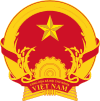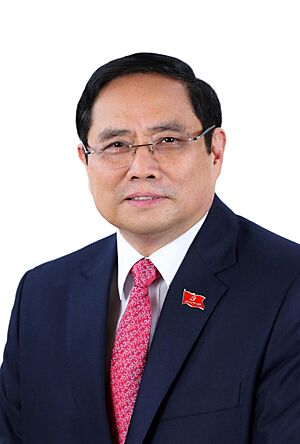Prime Minister of Vietnam facts for kids
Quick facts for kids Prime Minister of the Socialist Republic of Vietnam |
|
|---|---|

Emblem of Vietnam
|
|
| Office of the Prime Minister | |
| Style | Mr Prime Minister (informal) His Excellency (diplomatic) Đồng chí (internal) |
| Member of |
|
| Reports to |
|
| Seat | Government Office |
| Appointer | National Assembly |
| Term length | Five years, renewable |
| Inaugural holder | Phạm Văn Đồng |
| Formation | 2 September 1945 |
| Salary | 29,250,000₫ monthly |
The Prime Minister of Vietnam is the main leader of the country's government. They are in charge of the Government and lead its meetings. The Prime Minister also guides the work of other government members. They can suggest new deputy prime ministers to the National Assembly.
The Prime Minister is responsible to the National Assembly. They also help lead the Council for Defence and Security. Plus, the Prime Minister leads the Council for National Education. They are also a key member of the Central Military Commission and the Central Police Party Committee. A Prime Minister serves for five years and can be chosen again for another term. The current Prime Minister, Phạm Minh Chính, has been in office since 2021. If the Prime Minister cannot do their job, a deputy prime minister steps in temporarily.
The power of the Prime Minister has changed over time. Phạm Văn Đồng, Vietnam's first Prime Minister after the country became one, sometimes felt he did not have much power. Since 1988, the Prime Minister has been ranked third in importance. This ranking is within the Politburo, which is the top decision-making group in Vietnam.
History of the Role
Ho Chi Minh became Vietnam's first Prime Minister in 1946. He was also the country's president at the time. He was chosen by the National Assembly. Before that, he had served as the acting leader of the government. This happened right after the 1945 August Revolution. Both the 1946 and 1959 laws said that the National Assembly could choose and remove the Prime Minister.
From 1981, the Prime Minister led the Council of Ministers. This was the highest executive group in the country. In 1992, this group was renamed the Government. The title of Prime Minister was changed in 1980 to Chairman of the Council of Ministers.
Phạm Văn Đồng was the Prime Minister of North Vietnam from 1955. In 1976, he became the Prime Minister of a united Vietnam. He stayed in this role until he stepped down in 1987. When he resigned, he had served longer than any other Prime Minister in Vietnamese history. He was also the oldest Prime Minister in the world at that time. He sometimes said he felt like one of the weakest prime ministers. He once said, "I can do nothing. When I say something, nobody listens." Since the death of Phạm Hùng in 1988, the Prime Minister has been the third most important person in the Politburo.
What the Prime Minister Does
The National Assembly chooses the Prime Minister. This happens after the President of Vietnam suggests someone. The Prime Minister is responsible to the National Assembly. The Assembly also chooses all the ministers who work in the government. The Prime Minister must give reports about their work to the National Assembly. The Standing Committee of the National Assembly watches over the work of the government and the Prime Minister. Also, members of the National Assembly can ask questions to the Prime Minister and other government members.
The Prime Minister is the only government member who must also be a member of the National Assembly. This is because the Prime Minister answers to the National Assembly. They report to it, or to its Standing Committee, and to the President. The Prime Minister gives out instructions. They also make sure that orders from the President, the National Assembly, or the Standing Committee are followed.
Other government members are responsible to the Prime Minister and the National Assembly. They are in charge of their specific areas of work. According to Vietnam's laws, here are some of the Prime Minister's main duties:
- To lead the main government and guide the work of its members.
- To suggest to the National Assembly if new government departments should be created or closed.
- To propose to the National Assembly who should be chosen or removed as deputy prime ministers or ministers.
- To choose or remove deputy ministers and other high-ranking officials.
- To approve the selection or removal of leaders of local governments in provinces and cities.
- To stop or cancel decisions made by ministers or local governments if they go against the country's laws.
- To regularly tell the public about important issues the government is working on.
- If the Prime Minister is away, they must choose one of their deputy prime ministers to lead the government.
The Prime Minister also serves as the secretary of a special group called the CPV Government Caucus Commission. The National Assembly chairman is the deputy leader of this group. This commission has ten members, all of whom hold government jobs. The members are chosen by the Politburo. The commission reports to the Politburo and another group called the Secretariat. Decisions in this commission are made by everyone working together.
hi:वियतनाम के प्रधान मंत्री
See also
 In Spanish: Primer ministro de Vietnam para niños
In Spanish: Primer ministro de Vietnam para niños


